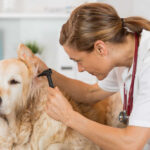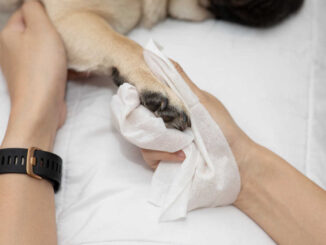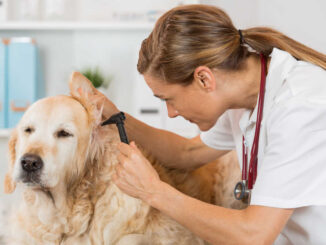
This article was updated on January 14th, 2024

Yeast infections in dogs can be a persistent and uncomfortable problem, causing a range of symptoms such as itching, inflammation, and odor. One possible approach to treating and preventing yeast infections in dogs is the use of probiotics. These microorganisms may help restore balance to good bacteria in the gut and strengthen the immune system, creating an inhospitable environment for harmful yeast overgrowth.
In this article, we will discuss the benefits of probiotics and provide recommendations for the best probiotics for dogs for yeast infections (including links to purchase on Amazon).
Can probiotics help dogs with yeast infections?
Maybe: there is promising evidence that they may be beneficial in reducing the severity of skin conditions such as atopic dermatitis (an allergic condition often associated with yeast infections). More research needs to be done on the use of probiotics for treating yeast infections in dogs, but here’s how they may help:
- Balancing good bacteria in the gut: Probiotics help restore and maintain a healthy balance of bacteria by competing with harmful microorganisms for nutrients and attachment sites on the intestinal wall. This competition helps prevent the overgrowth of pathogenic bacteria and yeast. This may be especially helpful for dogs who are on antibiotics for bacterial skin infections, which can sometimes kill off these good bacteria.
- Strengthening the immune system: Probiotics can enhance the immune response by stimulating the production of immune cells, cytokines, and antibodies. This improved immune function can better protect dogs from infections, including yeast infections.
- Preventing harmful bacterial overgrowth: Some probiotics can produce antimicrobial substances that inhibit the growth of harmful bacteria and yeast. These substances help create an unfavorable environment for pathogenic organisms, preventing them from thriving and causing infections in dogs.
However, probiotics alone are usually not enough.
Despite the potential benefits, probiotics are not a substitute for veterinary care or more traditional treatments for yeast infections. They should be used as part of a prevention plan and/or in conjunction with other treatments, including topical and oral anti-fungal medications.
4 best probiotics to help with a yeast skin infection in dogs
When selecting a probiotic product for your dog, it is important to choose a high-quality, reputable brand. Look for products that have undergone thorough testing and provide clear information about the strains and concentrations of microorganisms used, as well as any additional ingredients. Opt for products that are specifically formulated for dogs to ensure safety and effectiveness.
We have done the research for you and recommend the following:
Made by Purina, Fortiflora contains Enterococcus faecium. This probiotic is commonly recommended by vets and is backed by research. It is available as a flavored powder that can be sprinkled over one meal per day and now as a chewable treat.
- Number one probiotic supplement recommended by veterinarians (Kantar Veterinary Tracker, 2020)
This is an excellent product made by Nutramax and contains seven strains of bacteria as well as prebiotics. It has been in clinical trials and also comes in other formulations, including capsules and paste.
Containing 112.5 billion live bacteria per capsule or 225 per packet and eight different strains, this product is potent and has been in several clinical trials.
- POWERFUL PROBIOTIC BLEND: Contains 8 clinically-tested strains with a potent 112.5 billion CFU per capsule. Designed for optimal gut health in both men and women.
Tablets and capsules containing four live cultures, prebiotic inulin, and palatable flavor make this product a solid and cost-effective choice, although less backed by research than the others.
- Contains guaranteed amounts of four different live, active cultures (Enterococcus faecium, Lactobacillus acidophilus, Lactobacillus casei, Bacillus coagulans) and pre-biotic inulin. Also contains Vitamins A, E, and C
How effective are probiotics at treating yeast infections in dogs?
Additional research is needed to determine if probiotics are truly beneficial in helping to manage yeast infections in dogs. Currently, as a veterinarian, I prefer to reach for the more traditional treatments, including topical and oral anti-fungal medications, especially if cost is an issue for a pet parent. However, probiotics are beneficial in other ways, extremely safe, and may help in some cases.
They certainly can’t hurt. If you are interested in using probiotics to help treat a yeast infection in your dog, you should discuss this option with your vet. They may recommend probiotics based on the severity, underlying cause, and concurrent use of antibiotics.
Besides using probiotics, do you need to use other treatments for a yeast infection in dogs?
Probiotics alone are usually not enough to treat a yeast infection in dogs. A veterinary exam, diagnostics, and treatments will be required.
Here are some other treatments commonly used for a yeast infection in dogs:
1. Topical treatments: There are a variety of medicated shampoos, sprays, and creams that can be used to treat yeast infections in dogs. Ear infections or localized infections (affecting only one area of the body) are generally treated with a topical ointment containing antifungals, antibiotics, and anti-inflammatories. If the yeast infection is affecting a larger area of your dog’s skin, then medicated shampoo is highly recommended. These shampoos contain ingredients such as chlorhexidine, miconazole, or ketoconazole. To be most effective, shampoo needs to be applied twice weekly and sit on the skin for ten minutes before rinsing.
Mild yeast infections may respond to bathing with a calming shampoo, antifungal shampoo, or medicated wipes. You can also check out our guide to home remedies for ear infections. Consider a product like this, which contains ketoconazole to help target yeast.
- DOUXO S3 CALM Shampoo helps provide your dog or cat with soothing relief from the discomfort of itching and inflamed skin due to allergies
- #1 non-prescription topical brand used and recommended by U.S. veterinarians for dogs and cats with infections/inflammatory dermatological disease
2. Oral medications: For severe infection, oral anti-fungal medications like ketoconazole may be needed. These medications often need to be given for long periods of time (weeks to months) and may cause side effects or affect liver function. Therefore, your veterinarian may recommend bloodwork before and during the course of treatment. Additionally, many dogs with yeast infections also have bacterial skin infections and will require antibiotics.
3. Management of inflammation and allergies – If your dog is extremely itchy and uncomfortable, they may be prescribed additional medications such as Apoquel, Cytopoint, or steroids. These medications can also help manage symptoms of environmental allergies.
4. Diet changes: If a food allergy is suspected, you may need to feed a prescription hydrolyzed protein diet. You may have heard that grain-free dog foods that use low-glycemic carbohydrates like legumes, peas, or sweet potatoes may be beneficial for preventing yeast infections; however, studies have recently linked these diets to the development of heart disease in dogs.
5. Omega-3 fatty acids: Omega-3 fatty acids help to support the skin’s natural barrier function and prevent the overgrowth of yeast. Omega-3 supplements can be added to your dog’s diet, or you can choose foods that are naturally high in omega-3s.
- WHY OMEGA-3 PET - This Nordic Naturals pet product is made with the same exceptional quality oil as our human products, but has been specially formulated for your dog. Omega-3 Pet features omega-3 fish oil in soft gels.
8. Precautions at home: Here are some common strategies used by dog owners to help prevent or reduce the risk for yeast infections in dogs:
- Keep your dog dry after swimming or bathing: Yeast thrives in a moist environment.
- Keep your dog from chewing at himself by applying an e-collar: Yeast infections cause itching. Excessive licking and chewing can cause skin irritation and infection and should be prevented with an E-collar.
- Wipe off paws after coming inside to help remove allergens.
- Clean your dog’s ears and/or pluck ear hair if recommended by your vet.
- Use year-round flea prevention for all pets in the household.
- Discuss underlying allergies with your vet and come up with a treatment plan.
Important note on natural remedies
Some natural remedies like apple cider vinegar, coconut oil, and tea tree oil may be irritating or toxic if used incorrectly. It’s important to consult with a veterinarian before using any over-the-counter treatments for your dog’s yeast infection. They can help you determine the best course of treatment based on your dog’s individual needs and the severity of the infection.
What happens if my dog doesn’t get the right treatment
If your dog does not receive treatment for a yeast infection, the infection can spread and become more severe. Yeast infections in dogs can cause a variety of health problems, including skin infections, ear infections, and digestive problems.
Veterinarian diagnosis
Confirming a yeast infection diagnosis in dogs typically involves a combination of physical examination and skin or ear swab testing. If your dog has suffered from chronic or recurrent yeast infections, your vet will likely recommend pursuing additional testing to help determine the underlying cause.
Here are the steps that a veterinarian may take to confirm a yeast infection diagnosis in dogs:
1. Physical Examination: The veterinarian will examine your dog’s skin, ears, and any other affected areas for signs of a yeast infection. They will also ask you about your dog’s medical history and any symptoms they are experiencing.
2. Cytology – Your vet will collect a sample from the skin or ear for evaluation under the microscope. This may be done by pressing a glass microscope slide against the skin or using a piece of tape to collect skin cells. In the case of an ear infection, they will take a swab of debris from your dog’s ear. Evaluation under the microscope should determine if it is yeast, bacteria, or both that are causing the infection.
3. Skin scraping – This is another way to collect a small skin sample to look for the presence of yeast organisms as well as mites (Demodex or Scabies), which can predispose dogs to skin infections.
4. Biopsy – In more severe cases or those resistant to treatment, a larger piece of skin may be removed via a punch biopsy.
5. Bloodwork – If your vet is concerned about systemic diseases that may predispose your dog to skin infections, such as hypothyroidism or Cushing’s Disease, bloodwork may be indicated.
6. Allergy testing – Allergy testing may involve referral to a dermatologist for a skin test, a blood test, or a feeding trial with a hypoallergenic diet.
Once a yeast infection diagnosis has been confirmed, the veterinarian will work with you to develop a treatment plan based on the severity and location of the infection. This may include anti-fungal medications, topical treatments, diet changes, and/or allergy management. Regular follow-up appointments may be needed to monitor the progress of the treatment and ensure that the infection is fully resolved.
Prognosis – How do dogs recover from yeast skin infections?
When diagnosed and treated early, the prognosis for a yeast infection in dogs is very good: most dogs recover fully from a yeast infection within 2-4 weeks. However, the prognosis of a yeast infection varies depending on the severity of the infection and any underlying health conditions. For some dogs this may take months or be a lifelong issue.
What is the cost of veterinary treatments?
The cost of veterinary care for a yeast infection in a dog can vary depending on a number of factors, such as the severity of the infection, the location of the infection, and the region in which you live, and whether you are referred to a veterinary dermatologist. Here are some factors that can influence the cost of veterinary care for a yeast infection in a dog:
1. Initial Consultation: The cost of an initial consultation with a veterinarian can range from $50 to $250 or more, depending on the location and experience of the veterinarian.
2. Diagnostic Tests: Diagnostic tests like skin or ear swabs and blood tests may be needed to confirm a yeast infection diagnosis and can cost anywhere from $50 to $500 or more depending on the type of test and the laboratory used.
3. Medications: Anti-fungal medications, topical treatments, and other medications prescribed to treat a yeast infection can range in cost from $20 to $200 or more, depending on the type and duration of treatment.
4. Follow-up Appointments: Follow-up appointments may be needed to monitor the progress of the treatment and ensure that the infection is fully resolved. The cost of follow-up appointments can range from $50 to $150 or more.
Overall, the cost of veterinary care for a yeast infection in a dog can range from a few hundred dollars to over a thousand dollars, depending on the factors mentioned above. It’s important to discuss the cost of veterinary care with your veterinarian and ask about any available payment options or pet insurance coverage.
Signs that your dog needs to see the vet for a yeast infection
Anytime your dog has a new rash or itchy ears and feet, it’s a good idea to visit the vet. Here are some other signs that a dog needs to see a vet for a yeast infection:
1. Itching: Yeast infections in dogs can cause intense itching, which may cause the dog to scratch or bite at the affected area excessively.
2. Redness and Inflammation: The skin or ears affected by a yeast infection may appear red, inflamed, or irritated.
3. Odor: Yeast infections in dogs can cause a strong, unpleasant odor, especially in the ears.
4. Discharge: Dogs with yeast infections may have discharge from their ears or other affected areas, which can be thick, dark, and sometimes bloody.
5. Changes in Behavior: Some dogs with yeast infections may become lethargic, lose their appetite, or become more irritable due to the discomfort caused by the infection.
FAQ
What is the best probiotic for my dog?
There are several probiotic strains that are most commonly seen in probiotics for dogs. These include Enterococcus faecium, Bifidobacterium animalis, and Lactobacillus. When choosing a probiotic supplement for your dog, it is important to look for one that contains a variety of beneficial strains, including those listed above. It is also important to choose a high-quality supplement from a reputable brand that is specifically formulated for dogs. Consult your vet and follow the dosing instructions carefully.
When should I give a probiotic to my dog?
While all dogs may benefit from probiotics, they may be especially useful in the following situations:
- Acute or chronic gastrointestinal upset
- Dogs who are currently taking antibiotics
- Dogs with anxiety
- Dogs with other chronic conditions such as dental disease, obesity, chronic kidney disease, calcium oxalate uroliths (bladder stones), and atopic dermatitis (allergies)
What are probiotics?
Probiotics are live, beneficial microorganisms that confer health benefits when consumed or applied to the body in adequate amounts. They are often referred to as “good” or “friendly” bacteria. The health benefits of probiotics include promoting a healthy balance of gut bacteria, supporting the immune system, aiding digestion, and protecting against harmful pathogens. Their positive effects extend beyond gut health and can help address a variety of health issues in humans and animals alike.
Related posts:
Disclaimer: This website's content is not a substitute for veterinary care. Always consult with your veterinarian for healthcare decisions. Read More.

















Be the first to comment